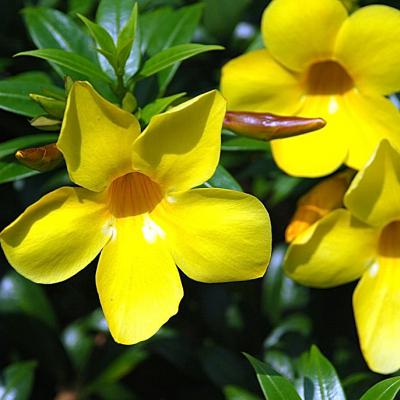Apocynaceae-Allamanda-cathartica L. var. grandiflora
Classification
- Botanical Family : Apocynaceae
- Genus : Allamanda
- Epithet : cathartica L. var. grandiflora
- German Family Name: Hundsgiftgewächse
- English Name: Yellow Allamanda
- Thai Name: บานบุรีแคระ
- Thai Phonetic: baan buri kaera
- Author: L.H.Bailey & Raffill
- Height: 1.50
Water Requirements
Plant Type
Light Requirements
Cultivation
Allamanda cathartica var. grandiflora is a small and compact shrub. Also, the leaves and flowers are smaller than at Allamanda binchetii or Allamanda cathartica var. hendersonii.
The plant is evergreen. The bright yellow flowers are a beautiful contrast with the dark green leaves.The plant blooms almost year-round. Suitable particularly to the edges of the path or as a low hedge as well as solitary plant.
A regular cut keeps the plant in the bushy shape and improves the perpetual blooming of the flowers on the ends of the branches.
The plant can be about 2 m high without cutting. A climbing aid, fence or wall, is required. The branches are not woody.
Allamanda cathartica is growing on clay soils, sandy clay soils and feels well in moist substrates. The soil should not dry out.
Prefers for full flowering a sunny place or a place in light shade.
All parts of the plant are poisonous. The milky sap can cause skin irritations.
Propagation: By cuttings of older shoots which have still leaves, by sowing or root division.
Allamanda cathartica var. grandiflora ist ein kleinwüchsiger und kompakter Strauch. Die Blätter und Blüten sind kleiner als bei Allamanda binchetii oder Allamanda cathartica var. hendersonii.
Die Pflanze ist immergrün. Die leuchtend gelben Blüten sind ein schöner Kontrast zu den dunkelgrünen Blättern. Die Pflanze blüht nahezu das ganze Jahr hindurch. Eignet sich besonders an Wegesrändern oder als niedrige Hecke, aber auch als Solitärpflanze.
Ein regelmäßiger Schnitt behält die Pflanze in buschiger Form und verbessert die Blühwilligkeit, da sich die Blüten nur an den Zweigenden bilden.
Ohne Verschnitt kann die Pflanze über 2 m hoch werden. Eine Kletterhilfe, Zaun oder Mauer, wo sich die Pflanze anlehnen kann, wird dann aber benötigt. Die Zweige verholzen nicht.
Allamanda cathartica var. grandiflora wächst auf Lehmböden, sandigen Lehmböden und fühlt sich in feuchten Substraten wohl. Der Boden sollte nicht austrocknen.
Bevorzugt zur Blütenbildung einen sonnigen bis leicht schattigen Platz.
Alle Teile der Pflanze sind giftig. Der Milchsaft kann zu Hautirritationen führen.
Vermehrung: durch Stecklinge von älteren Trieben, die aber noch Blätter haben, durch Aussaat oder Wurzelteilung.
Origin
Miscelaneous
Ethnomedical uses
The ethnomedical information is provided for general information only, it is not intended as guidance for medicinal use.
Leafes, flowers and roots are used.
Trinidad - Allamanda cathartica used in traditional medicine for treating malaria and jaundice.
A positive antibacterial wound healing could be demonstrated in a study in rats. (1)
Extracts of leaves, roots and flowers have been shown to have in vivo anti-tumour activity against leukaemia in mice, and against human carcinoma of the nasopharynx (nasal cavity and upper part of the throat) in culture. Leaf and root decoctions are used as a laxative and emetic in traditional medicine in a number of tropical countries, but large doses are toxic. (2)
(1) Evaluation of wound healing activity of Allamanda cathartica. L. and Laurus nobilis. L. extracts on rats Shivananda Nayak,1 Poorna Nalabothu,1 Steve Sandiford,1 Vidyasagar Bhogadi,1 and Andrew Adogwa2
Volksmedizinische Verwendung
Die Berichte über volksmedizinische Verwendung ist nur zur allgemeinen Information und nicht als medizinischer Ratgeber zu betrachten.
Verwendet werden Blätter, Blüten und Wurzel.
Trinidad - Allamanda cathartica wird als Mittel gegen Malaria und Gelbsucht eingesetzt.
Eine positive antibakterielle Wundheilung konnte in einer Studie an Ratten bewiesen werden. (1)
Extrakte von Blättern, Wurzeln und Blüten haben eine in vivo Anti-Tumor-Aktivität gegen Leukämie bei Mäusen und gegen die Karzinome des Nasopharynx (Nasenhöhle und oberen Teil des Halses) beim Menschen in angesetzter Kultur. Blätter- und Wurzelabkochungen werden als Abführmittel und Brechmittel in der traditionellen Medizin in einer Reihe von tropischen Ländern verwendet, aber große Dosen sind giftig. (2)
(1) Evaluation of wound healing activity of Allamanda cathartica. L. and Laurus nobilis. L. extracts on rats Shivananda Nayak,1 Poorna Nalabothu,1 Steve Sandiford,1 Vidyasagar Bhogadi,1 and Andrew Adogwa2


